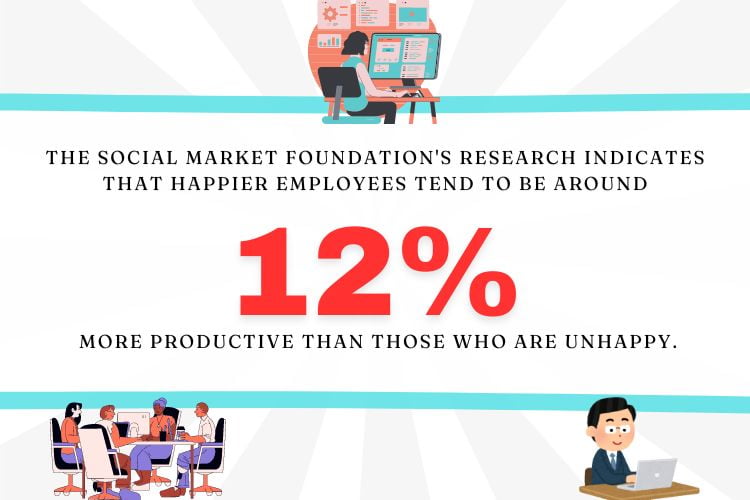A good workplace creates productivity, creativity, and innovation. It helps employees perform their best as they work together to achieve shared goals. A positive work environment boosts morale and reduces stress levels, which leads to increased overall efficiency. In this article, we will discuss some of the characteristics of a good workplace.

Jump To Section
What is a Good Workplace?
When it comes to finding an ideal work environment, some people might opt for a relaxed and stress-free setting, while others might prefer a more stimulating one. However, the most important factor in determining whether or not a person will be satisfied with their job is the people they work with.
If the team is cohesive and supportive, then most people will be content. Conversely, if there is a lack of trust or camaraderie among coworkers, then employees may feel isolated and unhappy. To create an environment that fosters productivity and cooperation, it is essential to create a balance between personal and professional life.

What are the Qualities of a Good Workplace?
The characteristics of a positive workplace are:
Offer Challenging and Meaningful Work
The work you do is an important part of your life. It’s where you spend most of your time, and it can have a big effect on both how much energy and motivation you bring to every other aspect of your life. If the work you do isn’t challenging, or if it doesn’t make a difference in some way, then there’s no reason for you to put energy into doing it well. The same goes for the people around you at work. If they don’t see their work as meaningful, they may not be very engaged in their tasks or excited about coming to work each day.
To create positive workplaces that foster engagement among employees, managers should strive to offer meaningful and challenging opportunities for growth at all levels within the organization. This means offering new kinds of projects that allow people with different areas of expertise (and different skill sets) to improve those skills.
Hire and Retain Great People
Hiring and retaining great people is a huge part of building a positive workplace. The best employees will be able to do their jobs well as well as help others do theirs. They’ll have an eye for detail and be organized enough to get things done on time.
This is all easier said than done. Especially since many companies don’t have practices for hiring employees who are great at their jobs or who fit into the company culture or team’s personality traits. But if you can build these practices into your hiring process, it’ll make life so much easier down the road when you’re trying to retain good employees!
Value and Reward Employee Contributions
Employees want to feel valued and recognized. The best way to do this is by recognizing individual contributions, not just their role or title. We’ve all been there, you do a great job, but your boss gives the credit to someone else. If you want to create a positive environment, make sure your recognition is based on performance and not just what department they belong in or what position they hold.
The key here is consistency. Recognize employee contributions regularly and consistently so employees don’t get used to being overlooked for praise or rewards.
Guide, Support, and Develop Top Performers
A good workplace provides coaching and mentoring, giving feedback, and providing learning opportunities. A great workplace takes it a step further and also provides growth opportunities.
If you’re a manager, you don’t want to be known as the person who just focuses on finding fault with everyone. You can help your employees grow by making sure they get the guidance, support, and development they need from you or their peers within the organization.
Offer an Environment of Feedback

One of the most important qualities of a good workplace is that it offers employees the ability to give and receive feedback. Feedback is essential for employees to grow, but it’s also an important part of creating a supportive environment at work.
Feedback should be timely, specific, and given in private. It should be given in a positive manner and with constructive criticism rather than just pointing out flaws or mistakes that were made. Feedback can also be given in a group setting so as not to make one employee feel singled out by what others have said about them.
Finally, feedback should always be done with encouragement for improvement instead of being passive-aggressive or overly critical so that your co-workers will not feel their worth as employees. Try to conduct most feedback positively.
Supports Good Work-Life Balance
Work-life balance is about achieving a healthy work-life balance. It’s about finding the right balance between your work and personal life. This means being able to spend time with family members, friends, and pets. Having time for yourself or relaxing after a long day of work. Doing activities you enjoy such as yoga or going to the gym. Eating healthy food and exercising regularly.
Offers Career Development
Offering career development opportunities is a great way to ensure you have an engaged and productive workforce. This type of investment in your employees can be beneficial for both the individual and the organization.
Career development programs provide employees with the opportunity to gain new skills, explore new career paths, and identify their own goals for personal growth. It also ensures that employees remain up-to-date on changes in their industry, stay competitive in their field, and enhance their knowledge and expertise. Offering career development opportunities is an important step towards creating an environment where employees feel supported and invested in by the company they work for.
Have Open Communication

Open communication is an important characteristic of a good workplace. When everyone is open and honest about their thoughts and feelings, it allows for productive conversations that can help resolve conflicts and build trust.
Open communication also encourages collaboration by allowing everyone to contribute ideas, opinions, and experiences in a safe space. This helps foster a sense of ownership in whatever is being discussed, which can lead to improved morale and better decision-making.
Additionally, open communication can make sure everyone is on the same page with expectations, tasks, deadlines, etc., leading to smoother operations for the team or relationship involved. Overall, having an environment of open communication will create a stronger bond between those involved and lead to greater success in whatever they are trying to accomplish.
Provide Positive Workplace Culture
A positive workplace culture creates an atmosphere where trust is built between employees, making them feel comfortable with each other and allowing them to work together more effectively. It also encourages employees to be engaged in their jobs instead of just going through the motions at work every day without much enthusiasm or passion for what they’re doing or feeling like they’re part of something bigger than themselves (this is especially true if you’re an organization that makes a difference in people’s lives).
By taking steps towards building a positive workplace culture, you’ll notice an increase in employee satisfaction and engagement levels as well as lower turnover rates. This means that your company will benefit from decreased time spent recruiting new hires while still getting great results!
Foster Teamwork
Teamwork is a key component of a positive workplace.
Here’s why:
- It is important for the success of the company. You can’t have a successful team without teamwork, and you can’t be successful without a good team.
- It is important for the success of the employees. If you’re not working with others in your department or company, then there’s no way to complete your job efficiently and effectively.
- It is important for workplace culture as well as individual job satisfaction, which directly affects productivity and results!
Promote Employee Health and welfare
Provide health and wellness programs to your employees, such as a comprehensive health plan, employee assistance programs (EAP), flexible work arrangements, onsite fitness facilities, and healthy food options. You can also offer smoking cessation programs or weight loss programs to help your employees lead healthier lives at work. It will encourage them to be more productive at their jobs because they feel good about themselves after exercising or eating healthy foods.
Strong Purpose and Core Values
One of the first steps in creating a strong workplace is to define your company’s purpose and core values. A strong purpose statement tells employees why they do what they do and gives them a sense of pride in their work. Your core values are the guiding principles that help employees stay consistent with the company’s mission, while also providing flexibility so that they can be creative within certain parameters.
When you have this information down, communicate it effectively to all members of your team so that everyone knows what the end goal is and shares a similar vision for how things should be done. This way, everyone is on the same page when it comes time for decisions about projects or goals. There won’t be any confusion about whether or not something aligns with the business’s overall objectives. Additionally, as long as everyone understands what these core principles are supposed to stand for (e.g., honesty), then no one will feel pressured into violating them if doing so means achieving success at work (e.g., lying).
Exhibit Positive Leadership

A good workplace is one where the employees feel valued and respected, and the leaders are a part of that. A leader’s role is to inspire, motivate, and encourage those around them. The best leaders are visible, accessible, and approachable. They take responsibility for their actions, delegate effectively, listen well, and empower their team.
If you want your company to be successful then your leaders must exhibit positive leadership qualities so that they can set an example for others in the organization.
Have A Clear, Common Goal
The goal of the workplace is to create a positive work environment for everyone. To do this, you must have a clear and common goal that everyone understands. The goal should be achievable and measurable. It must be rewarding for all employees involved in achieving it, and relevant to every employee’s needs and interests. The important thing is the goal needs to be communicated to everyone.
Provide an Environment of Trust and Respect
When working in an environment of trust and respect, everyone can do their best work. This is because they know that their colleagues are looking out for them and will not tolerate any kind of abusive or harmful behavior. Creating an environment of trust and respect is not easy, but it is essential if we want to achieve the best results. It takes time and effort, but it is worth it in the long run.
Embrace Diversity
Diversity is an important part of any workplace. Not only does it help with keeping the business competitive in today’s modern world, but it also helps us learn from each other and grow as individuals.
It’s about getting to know our coworkers on a deeper level, seeing past their differences, and embracing them for their unique qualities. As an employee, you should be able to feel comfortable bringing up anything that concerns you at work without feeling like there will be repercussions for your opinions or beliefs. If a coworker says something that offends you, don’t automatically assume they are being sexist or racist. Instead, try asking them why they said what they did and get their perspective on the matter so that everyone can learn from one another’s experiences!
Why Does a Good Work Environment Matter?
In today’s fast-paced and competitive world, cultivating a good work environment is crucial for both employees and businesses. But why exactly does a good work environment matter? Let’s dive into the impact it has on productivity, employee satisfaction, and overall success.
Boosts Productivity
A positive work environment can work wonders when it comes to boosting productivity. When employees feel comfortable and supported in their work environment, they are more likely to be highly engaged and motivated. This, in turn, leads to increased efficiency and better results. So, creating a positive atmosphere can help businesses achieve their goals more effectively.
Enhances Employee Satisfaction
A good work environment plays a vital role in employee satisfaction. When employees feel valued, respected, and listened to, they are more likely to experience job satisfaction. This fosters a sense of loyalty and commitment towards their work, which can lead to longer retention and reduced turnover rates. Moreover, a positive work environment also promotes a healthy work-life balance, creating happier and more fulfilled employees.
Encourages Collaboration and Innovation
In a supportive and positive work environment, employees are encouraged to collaborate and share ideas freely. When individuals feel safe to express their thoughts and opinions without the fear of judgment or criticism, it cultivates a culture of innovation. This enables teams to work together, pool their talents, and come up with groundbreaking solutions that can drive the business forward.
Promotes Mental and Physical Well-being
A good work environment prioritizes the well-being of its employees. It recognizes the importance of mental and physical health by providing resources and support to maintain a healthy work-life balance. By promoting activities like exercise programs, mindfulness sessions, or flexible work arrangements, employers can help their staff reduce stress levels, increase focus, and improve overall well-being.
Enhances Company Reputation
A positive work environment not only benefits employees but also enhances a company’s reputation. When an organization is known for its supportive and inclusive culture, it becomes an attractive place to work. This can help in attracting top talent, who are more likely to opt for workplaces that prioritize employee welfare. A positive reputation can also lead to increased customer satisfaction, as employees are more likely to deliver exceptional customer service when they are content in their work environment.
Companies That Exhibit Characteristics of a Good Workplace
A good workplace can make all the difference. Let’s explore some examples of workplaces that stand out for the right reasons.
Google: The Benchmark Setter
Google isn’t only about innovative technology; it’s also a pioneer in employee happiness. With perks like on-site fitness centers and health and wellness options, Google knows how to look after its team members. They promote a healthy lifestyle and ensure that their employees have all they need to succeed.
Netflix: Respecting Your Time
Netflix has revolutionized more than just streaming; they’ve transformed the workplace too. Offering generous leave policies and valuing family time, Netflix wants its workforce to feel supported both in and out of the office. They understand that great employees are those who are well-rested and well-supported.
Zappos: A Culture of Happiness
At Zappos, it’s all about the culture. They focus on creating a happy and dynamic environment where mutual respect is the norm. They encourage their employees to bring different perspectives and go the extra mile to create a positive customer experience.
Finding Your Great Place
These companies show that when businesses invest in mutual respect, positive attitude, and employee engagement, they’re likely investing in their own success. When you’re on the lookout for that next opportunity, remember that you’re not just looking for a good leader or a strong management team, you’re looking for a second home. The best places to work are those who understand the long journey of growth, both for their business and their employees.
Conclusion
Now that we’ve gone over the qualities of a good work environment and positive work culture, you may be wondering what it looks like to create one. The first step is to start by looking at your own leadership style. Are you someone who embraces diversity? Do you encourage feedback from employees? Do you have open communication channels in place? If the answer is yes, then congratulations! You already have some of the characteristics needed for a positive workplace culture.
But if not, then it might be time to take a look at how your company functions as an organization before making any changes. Remember, it takes time and patience to build these types of environments where people are happy working together towards common goals.
Did you find this article useful? Let me know by sharing and subscribing below.


